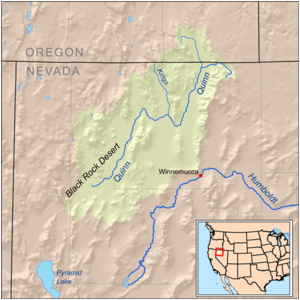Kings River (Nevada) facts for kids
Quick facts for kids Kings River |
|
|---|---|

Quinn River watershed, including Kings River watershed
|
|
| Country | United States |
| State | Nevada, Oregon |
| Physical characteristics | |
| Main source | west of Disaster Peak The Granites, Humboldt County, Nevada, Nevada 8,382 ft (2,555 m) 41°59′05″N 118°13′36″W / 41.98472°N 118.22667°W |
| River mouth | Quinn River Quinn River Lakes, Humboldt County, Nevada, Nevada 4,114 ft (1,254 m) 41°30′54″N 118°08′55″W / 41.51500°N 118.14861°W |
| Length | 40 mi (64 km) |
The Kings River is a river in the western United States. It flows for about 40 miles (64 km) through parts of Nevada and Oregon. This river is a branch, or "tributary," of the Quinn River.
The Kings River helps drain a dry, faraway area in the northwestern part of the Great Basin. The Great Basin is a large region in the western U.S. where rivers and streams do not flow into an ocean. Instead, they flow into lakes or dry up.
Contents
Journey of the Kings River
The Kings River begins in northern Humboldt County, Nevada. Its source is west of a place called Disaster Peak. This area is part of The Granites, which are mountains within the Trout Creek Mountains. The river starts its journey close to the border with Oregon.
Flowing Through States
At first, the Kings River flows northwest. It briefly crosses into Harney County, Oregon. Then, it makes a sharp turn south. After this turn, the river flows back into Humboldt County, Nevada, for the rest of its path.
Mountains Along the Way
As the river travels south, it flows between different mountain ranges. On its right side (west), you'll find the Bilk Creek Mountains. On its left side (east), it passes by the Montana Mountains and then the Double H Mountains.
Where the River Ends
The Kings River eventually joins the Quinn River from the north. This meeting point is at a place called Quinn River Lakes. From these lakes, the Quinn River continues to flow southwest. It ends in a "sink" in the Black Rock Desert. A sink is an area where water collects but has no outlet to the sea, so it either evaporates or soaks into the ground. This sink is located west of the city of Winnemucca, Nevada.

